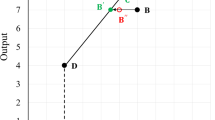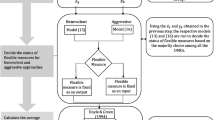Abstract
In this paper we present a new model combining the major underlying ideas behind the Slacks-Based Measure (SBM) and the Data Envelopment Analysis-Ratio based (DEA-R) models. This new proposed model computes efficiency and super-efficiency scores based on the corresponding slack values for both input/output and output/input ratios, depending upon the orientation of the production frontier. A comprehensive step-by-step derivation of the SBM-DEA-R model in light of previous approaches is offered to readers. Besides, in order to show the validity of the approach proposed in light of the current body of literature, we revisit a case study of twenty-one medical centers in Taiwan. Limitations and directions for future research are discussed.


Similar content being viewed by others
References
Allen R, Athanassopoulos A, Dyson RG, Thanassoulis E (1997) Weights restrictions and value judgments in data envelopment analysis: evolution, development and future directions. Ann Oper Res 73:13–34
Andersen P, Petersen NC (1993) A procedure for ranking efficient units in data envelopment analysis. Manage Sci 39(10):1261–1264
Andreu L, Sarto JL, Vicente L (2014) Efficiency of the strategic style of pension funds: an application of the variants of the slacks-based measure in DEA. J Op Res Soc 65(12):1886–1895
Charnes A, Cooper W (1990) Polyhedral cone-ratio DEA models with an illustrative application to large commercial banking. J Econ 46:73–79
Charnes A, Cooper WW, Rhodes E (1978) Measuring the efficiency of decision making units. Eur J Oper Res 2:429–444
Charnes A, Cooper WW, Golany B, Seiford L, Stutz J (1985) Foundations of data envelopment analysis for Pareto-Koopmans efficient empirical production functions. J Econ 30(1):91-l07
Chen Y (2005) Measuring super-efficiency in DEA in the presence of infeasibility. Eur J Oper Res 161(2):545–551
Chen A, Hwang Y, Shao B (2005) Measurement and sources of overall and input inefficiencies: evidences and implications in hospital services. Eur J Oper Res 161(2):447–468
Chen Y, Li Y, Liang L, Wu H (2017) An extension on super slacks-based measure DEA approach. Ann Oper Res 278(1–2):1–21
Cook WD, Seiford LM (2009) Data envelopment analysis (DEA) - Thirty years on. Eur J Oper Res 192(1):1–17
Cooper WW, Seiford LM, Tone K (2002) Data Envelopment Analysis – A comprehensive text with models, applications, references and DEA-solver software. Kluwer, Massachusetts
Despic O, Despic M, Paradi JC (2007) DEA-R: ratio-based comparative efficiency model, its mathematical relation to DEA and its use in applications. J Prod Anal 28(1):33–44
Du J, Liang L, Zhu J (2010) A slacks-based measure of super-efficiency in data envelopment analysis: a comment. Eur J Oper Res 204(3):694–697
Emrouznejad A, Amin GhR (2009) DEA models for ratio data: convexity consideration. Appl Math Model 33(1):486–498
Emrouznejad A, Parker BR, Tavares G (2008) Evaluation of research in efficiency and productivity: a survey and analysis of the first 30 years of scholarly literature in DEA. Socioecon Plann Sci 42(3):151–157
Fang HH, Lee HS, Hwang SN, Chung CC (2013) A slacks-based measure of super-efficiency in data envelopment analysis: an alternative approach. Omega 41(4):731–734
Färe R, Grosskopf S (2010) Directional distance functions and slacks-based measures of efficiency: some clarifications. Eur J Oper Res 206(3):702
Fernandez-Castro A, Smith P (1994) Towards a general non-parametric model of corporate performance. Omega 22(3):237–249
Gerami J, Mozaffari MR, Wanke PF (2020a) A multi-criteria ratio-based approach for two-stage data envelopment analysis. Expert Syst Appl 158:113508
Gerami J, Kiani Mavi R, Farzipoor Saen R, Kiani Mavi N (2020b) A novel network DEA-R model for evaluating hospital services supply chain performance. Ann Op Res. https://doi.org/10.1007/s10479-020-03755-w
Guo IL, Lee HS, Lee D (2017) An integrated model for slack-based measure of super-efficiency in additive DEA. Omega 67:160–167
Hatami-Marbini A, Toloo M (2019) Data envelopment analysis models with ratio data: a revisit. Comput Ind Eng 133:331–338
Katharaki M (2008) Approaching the management of hospital units with an operation research technique: the case of 32 Greek obstetrics and gynecology public units. Health Policy 85(1):19–31
Kumar UD, Roy AB, Saranga H, Singal K (2010) Analysis of hedge fund strategies using slack based DEA models. J Op Res Soc 61(12):1746–1760
Lee HSh (2021a) An integrated model for SBM and Super-SBM DEA models. J Op Al Res Soc 72(5):1174–1182
Lee HSh (2021b) slacks-based measures of efficiency and super-efficiency in presence of nonpositive data. Omega 103:102395
Lee HS, Chu CW, Zhu J (2011) Super-efficiency DEA in the presence of infeasibility. Eur J Oper Res 212(1):141–147
Lin R, Yang W, Huang H (2019) A modified slacks-based super-efficiency measure in the presence of negative data. Comput Ind Eng 135:39–52
Liu ST, Chuang M (2009) Fuzzy efficiency measures in fuzzy DEA/AR with application to university libraries. Expert Syst Appl 36(2):1105–1113
Liu WB, Zhang DQ, Meng W, Li XX, Xu F (2011) A study of DEA models without explicit inputs. Omega 39:472–480
Liu JS, Lu LYY, Lu WM, Lin BJY (2013) A survey of DEA applications. Omega 41(5):893–902
Lozano S (2015) Alternative SBM model for network DEA. Comput Ind Eng 82:33–40
Mozaffari MR, Gerami J, Jablonsky J (2014a) Relationship between DEA models without explicit inputs and DEA-R models. CEJOR 22(1):1–12
Mozaffari MR, Kamyab P, Jablonsky J, Gerami J (2014b) Cost and revenue efficiency in DEA-R models. Comput Ind Eng 78(12):188–194
Olesen OB, Petersen NC, Podinovski VV (2015) Efficiency analysis with ratio measures. Eur J Oper Res 245(2):446–462
Olesen OB, Petersen NC, Podinovski VV (2017) Efficiency measures and computational approaches for data envelopment analysis models with ratio inputs and outputs. Eur J Oper Res 261:640–655
Pedraja-Chaparro F, Salinas-Jimenez J, Smith P (1997) On the role of weight restrictions in data envelopment analysis. J Prod Anal 8(2):215–230
Pham MD, Zelenyuk V (2018) Slack-based directional distance function in the presence of bad outputs: theory and application to Vietnamese banking. Empir Econ 54(1):153–187
Podinovski VV (2007) Computation of efficient targets in DEA models with production trade-offs and weight restrictions. Eur J Oper Res 181(2):586–591
Seiford LM, Zhu J (1999) Infeasibility of super-efficiency data envelopment analysis models. INFOR Inf Syst Op Res 37(2):174–187
Thompson R, Langemeier L, Lee C, Thrall R (1990) The role of multiplier bounds in efficiency analysis with application to Kansas farming. J Econ 46:93–108
Tone K (2001) Slacks-based measure of efficiency in data envelopment analysis. Eur J Oper Res 130(3):498–509
Tone K (2002) A slacks-based measure of super-efficiency in data envelopment analysis. Eur J Oper Res 143:32–41
Tone K, Tsutsui M (2009) Network DEA: A slacks-based measure approach. Eur J Oper Res 197(1):243–252
Tone K, Tsutsui M (2010) Dynamic DEA: a slacks-based measure approach. Omega 38(3–4):145–156
Tone K, Tsutsui M (2014) Dynamic DEA with network structure: a slacks-based measure approach. Omega 42(1):124–131
Tone K, Toloo M, Izadikhah M (2020) A modified slacks-based measure of efficiency in data envelopment analysis. Eur J Oper Res 287(2):560–571
Tran TH, Mao Y, Nathanail P, Siebers PO, Robinson D (2019) Integrating slacks-based measure of efficiency and super-efficiency in data envelopment analysis. Omega 85:156–165
Wei CK, Chen LC, Li RK, Tsai CH (2011a) A study of developing an input oriented ratio-based comparative efficiency model. Expert Syst Appl 38(3):2473–2477
Wei CK, Chen LC, Li RK, Tsai CH (2011b) Exploration of efficiency underestimation of CCR model: based on medical sectors with DEA-R model. Expert Syst Appl 38(4):3155–3160
Wei CK, Chen LC, Li RK, Tsai CH (2011c) Using DEA-R model in the hospital industry to study the pseudo-inefficiency problem. Expert Syst Appl 38(3):2172–2176
Wong H, Beasley J (1990) Restricting weight flexibility in data envelopment analysis. J Op Res Soc 41(9):829–835
Author information
Authors and Affiliations
Corresponding authors
Additional information
Publisher's Note
Springer Nature remains neutral with regard to jurisdictional claims in published maps and institutional affiliations.
Rights and permissions
About this article
Cite this article
Gerami, J., Mozaffari, M.R., Wanke, P.F. et al. A novel slacks-based model for efficiency and super-efficiency in DEA-R. Oper Res Int J 22, 3373–3410 (2022). https://doi.org/10.1007/s12351-021-00679-6
Received:
Revised:
Accepted:
Published:
Issue Date:
DOI: https://doi.org/10.1007/s12351-021-00679-6




